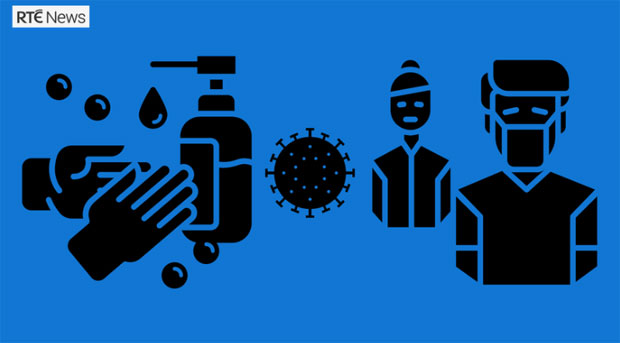
There are a lot of terms floating about in relation to Covid-19, the coronavirus that has been in the news since the beginning of 2020.
It can be hard to keep up with all the new words, so RTÉ’s news2day has devised a dictionary for children – or anyone who needs a primer.
Asymptomatic: This means showing no signs that you are sick even though you have been infected by the virus.
Cocooning: You might know the word cocoon from learning about caterpillars – it’s the silky, protective case they make to stay comfortable and safe until they emerge as butterflies. Nowadays cocooning means forming a protective barrier around older people, or those who have certain medical conditions, by reducing their close contact with other people.
Coronavirus: This is the name for one of the groups of viruses which cause colds. The latest coronavirus can affect your lungs and airways and is called Covid-19.
Covid-19: This stands for Coronavirus Disease 2019, and it’s because the first case was noticed in December 2019, in Wuhan in China.
Contact tracing: This happens after someone has tested positive for the virus and the health workers try to get in contact with anyone who had close contact with them.
Close contact: Someone who lives in the same house as a person who has tested positive for the virus. Or someone who has had direct physical contact, for example shaken hands. Also someone who has been in a room for more than 15 minutes at a distance of less than 2 metres from that person.
Community transmission: This is when a person catches the virus but hasn’t been in contact with a confirmed case and also hasn’t travelled outside Ireland. It means they must have caught the virus from somebody else in the community who hasn’t been identified yet.
Cluster: Sometimes groups of cases are confirmed in the same area, for example in a hospital or nursing home. These are known as clusters of cases.
Cough etiquette: Good manners when coughing. For example, coughing into your elbow or a tissue rather than into your hand or directly onto a surface.
Containment: This means trying to stop the spread of the virus at the beginning of the outbreak.
Essential services: Essential services are services that we need in order to survive. These include hospitals, supermarkets, buses, electricity and water services and, of course, TV, radio and online news!
Epidemic: This is when an infectious disease spreads easily from one person to another and a very large number of people are sick at the same time.
Epicentre: The place which has the greatest number of cases in that country or region. For example, New York is the epicentre for the eastern United States.
Fever: A fever is a temperature above 38 degrees Celsius. That’s when you can feel very hot and unwell, or cold and shivery.
Flattening the curve: This means both reducing the numbers of people getting sick and slowing down the rate of infection, so they don’t all end up in hospital at the same time.
Frontline staff: Doctors, nurses and other healthcare workers who treat patients with the coronavirus or come into contact with the virus at work.
Intubation: Putting a tube into somebody’s throat to open up the airway and help them to breathe.
ICU: Intensive Care Unit. This is the part of the hospital equipped with special machines and trained staff to treat patients who are seriously ill.
Lockdown: Strict rules to get people to stay at home, such as closing schools, restaurants and many businesses. Also limiting how far you can travel from your home. Many countries around the world have lockdowns at the moment.
Mitigation: This means trying to reduce the spread of the virus so it doesn’t have the worst effect.
Outbreak: A sudden increase in cases of a disease.
PPE: Personal Protective Equipment, such as gowns, masks, face shields and gloves for healthcare workers, which helps stop them catching the virus from patients.
Pandemic: A pandemic is when an epidemic (see above) spreads across the world.
Remote working: Doing your job from a different place, such as home.
Respiratory: Anything to do with breathing.
Reagent: This is stuff that is used to cause a chemical reaction. It’s needed to test whether Covid-19 is in the swab sample from an infected patient. (Swab explained below.)
Self-isolating: Staying away from other people because you either have or might have the virus. Self-isolation usually lasts 14 days from the first time you feel unwell.
Social distancing: Keeping a physical distance from other people – 2 metres is recommended.
Suppression: This means introducing severe restrictions to stop the spread of the virus.
Surge: When the number of cases rises most quickly.
Swab: A large cotton bud used to take a sample of cells from the back of your throat and the top of the inside of your nose.
Underlying conditions: Certain medical problems which can mean that the virus would have a much worse effect on someone.
Vaccine: This is a treatment which makes you better able to fight an infection by introducing a tiny bit of the germs into your body. It’s not enough to give you the disease, but enough that your immune system knows how to fight it in future.
Ventilator: A machine that helps you breathe.
Vulnerable groups: People who are more likely to get the virus, such as the elderly or people who already have certain medical problems.
WHO: The World Health Organization. Top doctors and scientists who advise governments about health.
Zoonosis: This is good word for impressing friends! It means a virus which can spread from animals to humans. It’s believed that Covid-19 began this way, as many of the first patients had visited or worked in a wildlife food market in Wuhan in China. It’s not certain what animal was involved, but some scientists think it may have been bats.
Source: RTE.ie
<< Return to COVID-19 Updates from Athboy Family Practice

